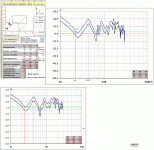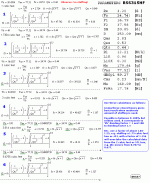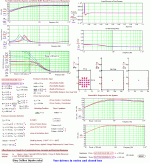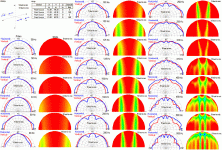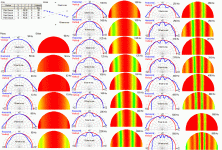I need to build two subwoofers to serve as sofa end tables in my HT room. The Bipole push-push design seems to be the right configuration since it doesn't "walk" and I can leave items on it during use. The height must be 24" and the baffle width 14" but the depth can vary as needed. I selected the PE RSS315HF as a starting point since John Krutke favors them and the price is reasonable. A sealed box is my 1st choice.
The numbers are as follows:
RSS315HF
FS 23Hz
Vas 3.0 cu. ft.
Qts 0.44
With a Qtc of 0.707
Vb 1.005 cu. ft.
F3 44.44Hz
I assume that the volume should be doubled to accommmodate the two driver bipole configuration. This puts the volume at 2.01 cu. ft. with dimensions of 24"x 14"x 10.3"
I realize that this is very simple but it is my first attempt to design and your input will be very welcome
Ray
The numbers are as follows:
RSS315HF
FS 23Hz
Vas 3.0 cu. ft.
Qts 0.44
With a Qtc of 0.707
Vb 1.005 cu. ft.
F3 44.44Hz
I assume that the volume should be doubled to accommmodate the two driver bipole configuration. This puts the volume at 2.01 cu. ft. with dimensions of 24"x 14"x 10.3"
I realize that this is very simple but it is my first attempt to design and your input will be very welcome
Ray
Thanks Prieter.....the internal volume will be maintained by adjusting the depth dimension as needed. I plan to use 3/4" plywood with internal bracing for rigidity.
What about the volume...is it correct?
Can the F3 be lowered?
Is the driver a good pick for the application?
My HT room is a spare bedroom and is only 13'x 14'.
Ray
What about the volume...is it correct?
Can the F3 be lowered?
Is the driver a good pick for the application?
My HT room is a spare bedroom and is only 13'x 14'.
Ray
Hi,
You’ve made a good choice of drivers but my advice is to download this program: http://www.pvconsultants.com/audio/reflection/downloads/room060d.exe and map/predict your possible room modes if you do not have measurement capability like a RTA before attempting to build smaller than rec. boxes.
In the .xls,Place your woofers at the relative positions you are suggesting and thereafter pick your listening position and run the program.
Save a screen dump of the plot. Copy to Paint.
Do the same thing with your main speakers and overlay the result on the first plot and evaluate your low-end room gain.
Look at the single plot of the first picture I submitted where it’s obvious that in this case there is no need for the sub to reach lower (–3dB point) than about 22 Hz or have a high Qtc** for the closed sub boxes as this room has gain.
A good investment is also to use a sub amp with adjustable variable notch or parametric Q controls to lower the 42 Hz rise in the FR-curve.
** In theory if you stuff your suggested 1.005 cubic feet box 100%, the Qtc will never reach lower than about 0.74 which probably is to high especially if your room has closed doors and you have no means to correct the FR curve at the very low end.
I would normally target a net volume close to 85 Litres/driver (about 3 cubic feet) without counting the ‘stuffing’ effects and use LT to lower the volume for a bipole sub if I ever would build one.
b
1(2)
You’ve made a good choice of drivers but my advice is to download this program: http://www.pvconsultants.com/audio/reflection/downloads/room060d.exe and map/predict your possible room modes if you do not have measurement capability like a RTA before attempting to build smaller than rec. boxes.
In the .xls,Place your woofers at the relative positions you are suggesting and thereafter pick your listening position and run the program.
Save a screen dump of the plot. Copy to Paint.
Do the same thing with your main speakers and overlay the result on the first plot and evaluate your low-end room gain.
Look at the single plot of the first picture I submitted where it’s obvious that in this case there is no need for the sub to reach lower (–3dB point) than about 22 Hz or have a high Qtc** for the closed sub boxes as this room has gain.
A good investment is also to use a sub amp with adjustable variable notch or parametric Q controls to lower the 42 Hz rise in the FR-curve.
** In theory if you stuff your suggested 1.005 cubic feet box 100%, the Qtc will never reach lower than about 0.74 which probably is to high especially if your room has closed doors and you have no means to correct the FR curve at the very low end.
I would normally target a net volume close to 85 Litres/driver (about 3 cubic feet) without counting the ‘stuffing’ effects and use LT to lower the volume for a bipole sub if I ever would build one.
b
1(2)
Attachments
Thanks bjorno. I tried the program you provided and only changed the ceiling height to 3.048 meters and W6 to account for carpet in the room. The numbers changed very little.
85 liters or 3 cubic feet per driver is too large for the available space. Do you think that RSS265HF 10" drivers would be better suited?
I intend to use a separate amp. and will include EQ ability.
Did I detect that you don't favor the bipole configuration?
Ray
85 liters or 3 cubic feet per driver is too large for the available space. Do you think that RSS265HF 10" drivers would be better suited?
I intend to use a separate amp. and will include EQ ability.
Did I detect that you don't favor the bipole configuration?
Ray
Based on Zaph's single driver RSS315HF 2 cu. ft. sub I have doubled the volume and adjusted the dimensions to suit my needs. The numbers are as follows:
External dimensions 24"x 14"x 26.75"
Internal dimensions 22.5"x 12.5"x 26.75"= 4.375 cu. ft. nominal volume
Driver vol. = 208 cu." ( 2 x 104 cu.")
Two shelf braces = 207 cu." (426 cu." + 211 cu."= 637 cu." less 430 cu." for holes )
2nd Baffle = 211 cu."
Total adjustment = 626 cu."
Net volume = 4 cu. ft.
Material is 3/4" plywood and 3/4"MFD for baffles and back of box.
Comments?
Ray
External dimensions 24"x 14"x 26.75"
Internal dimensions 22.5"x 12.5"x 26.75"= 4.375 cu. ft. nominal volume
Driver vol. = 208 cu." ( 2 x 104 cu.")
Two shelf braces = 207 cu." (426 cu." + 211 cu."= 637 cu." less 430 cu." for holes )
2nd Baffle = 211 cu."
Total adjustment = 626 cu."
Net volume = 4 cu. ft.
Material is 3/4" plywood and 3/4"MFD for baffles and back of box.
Comments?
Ray
Ray,
Yes, The difference in performance between the 10-inch and 12-inch bipole versions in a room like yours is minimal from what I can see but a little advantage for the 10” that slightly goes lower and has somewhat better bandwidth.
But a simple scaling of maximum possible SPL and input Power capability gives that you will only gain + 6 dB SPL at max if building with the 12 “ and also at the expense of needing twice the power.
From 10” to 12” gain is + 3dB due to the area difference everything else equal and bye doubling the power the gain is also + 3 dB. Se picture 1(3)
I doubt that your small room (acoustically untreated) can accommodate such high power levels without all the disadvantages that follow from possible room noises and distortions that will destroy any true fidelity when listening.
Yes, Simple bipole speakers are not good when placed close to corners or asymmetrically in respect to the walls.
See the basic free field dispersion pictures 2(3) to 3(3) where different bipole set-ups are simulated with ideal point source drivers.
Try to imagine when walls+sofa are added and all the mirror images that are occurring in conjunction with the walls, I believe it could work well if the subs are low-passed not higher than 50 Hz (based on your wall height) or even at a lower frequency.
Instead of 2 bipole, I favour 1 or 3 to 4 separated and spread out bass/sub-speakers with single drivers as much more versatile.
However if each of the drivers in a bipole has its own amplifier and also is physically separated from each other in the speaker box, then everything changes as the dispersion now can be steered in different ways.
The volume is ok.
b
1(3)
Do you think that RSS265HF 10" drivers would be better suited?
Yes, The difference in performance between the 10-inch and 12-inch bipole versions in a room like yours is minimal from what I can see but a little advantage for the 10” that slightly goes lower and has somewhat better bandwidth.
But a simple scaling of maximum possible SPL and input Power capability gives that you will only gain + 6 dB SPL at max if building with the 12 “ and also at the expense of needing twice the power.
From 10” to 12” gain is + 3dB due to the area difference everything else equal and bye doubling the power the gain is also + 3 dB. Se picture 1(3)
I doubt that your small room (acoustically untreated) can accommodate such high power levels without all the disadvantages that follow from possible room noises and distortions that will destroy any true fidelity when listening.
Did I detect that you don't favor the bipole configuration?
Yes, Simple bipole speakers are not good when placed close to corners or asymmetrically in respect to the walls.
See the basic free field dispersion pictures 2(3) to 3(3) where different bipole set-ups are simulated with ideal point source drivers.
Try to imagine when walls+sofa are added and all the mirror images that are occurring in conjunction with the walls, I believe it could work well if the subs are low-passed not higher than 50 Hz (based on your wall height) or even at a lower frequency.
Instead of 2 bipole, I favour 1 or 3 to 4 separated and spread out bass/sub-speakers with single drivers as much more versatile.
However if each of the drivers in a bipole has its own amplifier and also is physically separated from each other in the speaker box, then everything changes as the dispersion now can be steered in different ways.
Based on Zaph's single driver RSS315HF 2 cu. ft. sub I have doubled the volume and adjusted the dimensions to suit my needs.
The volume is ok.
b
1(3)
Attachments
- Status
- This old topic is closed. If you want to reopen this topic, contact a moderator using the "Report Post" button.
- Home
- Loudspeakers
- Subwoofers
- Bipole Sub design needs critique
